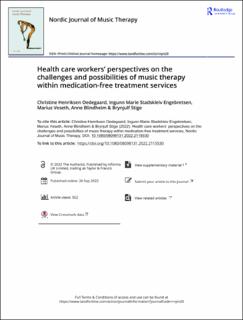| dc.contributor.author | Ødegaard, Christine Henriksen | |
| dc.contributor.author | Engebretsen, Ingunn Marie Stadskleiv | |
| dc.contributor.author | Veseth, Marius | |
| dc.contributor.author | Blindheim, Anne Alnes | |
| dc.contributor.author | Stige, Brynjulf | |
| dc.date.accessioned | 2022-12-30T08:59:08Z | |
| dc.date.available | 2022-12-30T08:59:08Z | |
| dc.date.created | 2022-10-22T17:39:36Z | |
| dc.date.issued | 2022 | |
| dc.identifier.issn | 0809-8131 | |
| dc.identifier.uri | https://hdl.handle.net/11250/3040022 | |
| dc.description.abstract | Introduction
In 2015, the Norwegian Regional Health Authorities introduced the possibility for people with psychotic disorders to choose medication-free services, with music therapy as a treatment option. This study aimed to explore the health care workers’ perspectives on challenges and possibilities of music therapy within these services.
Method
This is a qualitative study by an interdisciplinary research team, including experts by experience. Ethnographic notes provide data from participant observation with one patient using music therapy, describing what music therapy can be “a case of”. Focus group discussions (FGDs) with health care workers, including music therapists, explore their experiences with music therapy and medication-free treatment. These were transcribed and analyzed using systematic text condensation in a stepwise, iterative process involving co-authors to ensure reflexivity.
Results
The summary from the participant observation provides the reader with background information on how music therapy can unfold in mental health care. The informants from the FGDs described music therapy as having a high degree of treatment flexibility providing a continuous process of choices. The collaborative choices both among staff members as well as between patient and staff were experienced as important for treatment outcome. Patients worsening or stagnating increased the significance of contingent choices.
Discussion
The strengths of music therapy, such as its acceptability and flexibility, also represent challenges, including dilemmas of prioritization, challenges when ending therapy, and the need for close collaboration when assessing a patient’s worsening. There is a potential for improving the implementation of music therapy into the existing health care teams. | en_US |
| dc.language.iso | eng | en_US |
| dc.publisher | Taylor & Francis | en_US |
| dc.rights | Attribution-NonCommercial-NoDerivatives 4.0 Internasjonal | * |
| dc.rights.uri | http://creativecommons.org/licenses/by-nc-nd/4.0/deed.no | * |
| dc.title | Health care workers’ perspectives on the challenges and possibilities of music therapy within medication-free treatment services | en_US |
| dc.type | Journal article | en_US |
| dc.type | Peer reviewed | en_US |
| dc.description.version | publishedVersion | en_US |
| dc.rights.holder | Copyright 2022 The Author(s) | en_US |
| cristin.ispublished | true | |
| cristin.fulltext | original | |
| cristin.qualitycode | 2 | |
| dc.identifier.doi | 10.1080/08098131.2022.2115530 | |
| dc.identifier.cristin | 2063993 | |
| dc.source.journal | Nordic journal of music therapy | en_US |
| dc.identifier.citation | Nordic journal of music therapy. 2022. | en_US |

